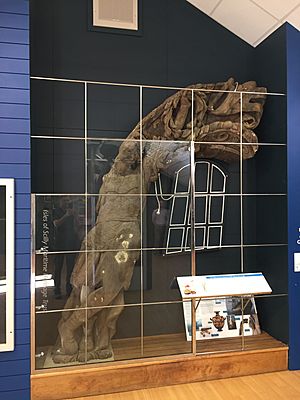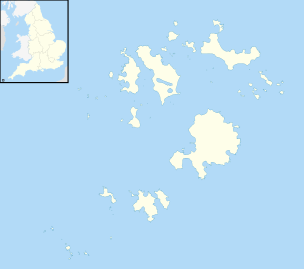HMS Colossus (1787) facts for kids
Quick facts for kids History |
|
|---|---|
| Name | HMS Colossus |
| Ordered | 13 December 1781 |
| Builder | Clevely, Gravesend |
| Laid down | October 1782 |
| Launched | 4 April 1787 |
| Fate | Wrecked, 10 December 1798 |
| Notes |
|
| General characteristics | |
| Class and type | Courageux-class ship of the line |
| Tons burthen | 1703 bm |
| Length | 172 ft 3 in (52.50 m) (gundeck) |
| Beam | 47 ft 9 in (14.55 m) |
| Depth of hold | 20 ft 9+1⁄2 in (6.3 m) |
| Propulsion | Sails |
| Sail plan | Full-rigged ship |
| Armament |
|
HMS Colossus was a powerful 74-gun warship of the Royal Navy. It was a "third-rate" ship of the line, meaning it was a large, important warship. Colossus was built in Gravesend and launched on April 4, 1787. Sadly, it was lost in a shipwreck on December 10, 1798.
During its time in service, Colossus took part in several major naval battles. These included the Battle of Groix, the Battle of Cape St Vincent, and the Battle of the Nile. After the Battle of the Nile, Colossus was carrying wounded sailors home when it was wrecked near the Isles of Scilly. Today, the wreck of Colossus is a protected site, looked after by Historic England.
Contents
Early Adventures at Sea
In June 1793, while sailing in the Bay of Biscay, Colossus captured a small French ship called Vanneau. This tiny vessel had only six guns. The Royal Navy later used Vanneau for its own purposes.
In the same year, Colossus joined a huge fleet of 51 warships. This fleet also included a Spanish squadron. The entire group was led by Vice Admiral Samuel Hood, 1st Viscount Hood.
The Siege of Toulon
The large fleet arrived off Toulon, a port city in France, on August 26, 1793. Lord Hood's main goal was to control the French fleet. There were 58 French warships in Toulon's port. Lord Hood did not want these powerful ships to fall into the hands of French revolutionary forces.
At that time, the Royalists (supporters of the French King) still controlled Toulon. When the British fleet arrived, the Royalists gave control of the town and ships to Lord Hood.
Sailors and Royal Marines from the British fleet landed at Toulon. They quickly took control of important forts. However, French Republican forces soon gathered and began a siege of Toulon on September 7.
By December 15, the British and Spanish forces had to leave. They took about 15,000 Royalists with them. They also destroyed the dockyards and many French warships. The Royal Navy lost 10 ships after the French captured the high ground overlooking the harbor.
The Battle of Groix
In 1795, Colossus was part of another big fleet battle, known as the Battle of Groix. A fleet of 25 British ships, led by Admiral Lord Bridport, fought a French fleet of 23 warships.
The battle was very large and confusing, spreading over a wide area. It ended without a clear winner. Lord Bridport ordered his fleet to stop fighting at 7:15 AM, just four hours after the battle began. This decision allowed nine important French warships to escape.
Colossus was damaged in the fight. Three of its crew members were killed, and thirty were wounded. Overall, the British lost 31 killed and 113 wounded. The number of French losses is not fully known, but it's thought that over 670 French sailors were killed or wounded. The British captured three French warships during the battle.
During this intense fighting, the Scottish captain of Colossus, John Monkton, had his piper play the bagpipes. The piper stood on the maintop mast staysail netting and played throughout the battle. This must have been a strange sight for the French sailors!
The Battle of Cape St. Vincent
In February 1797, Colossus was involved in another huge naval battle. This was the Battle of Cape St. Vincent. By now, Captain George Murray commanded Colossus.
The British fleet had 21 ships, including 7 smaller ones. It was led by Admiral John Jervis on his flagship, HMS Victory. They faced a Spanish fleet of 27 ships.
Colossus suffered serious damage during the battle. Its sails were almost completely torn away by cannon fire. It looked like Spanish warships would attack Colossus from the side, which was very dangerous. But then, Orion bravely moved in front of Colossus to protect it.
The battle was a major victory for the Royal Navy. Even though they were outnumbered, the British captured four Spanish ships. They also badly damaged seven others, including the largest warship in the world at that time, the Santísima Trinidad. Britain lost about 300 sailors killed or wounded. The Spanish lost 1,092 killed or wounded, and 2,300 were taken prisoner.
Journey Home and Shipwreck
After the Battle of Cape St. Vincent, the fleet repaired in Naples. Colossus was then sent on a patrol near Malta. It later went to Gibraltar before returning to the repaired fleet in Naples.
Later, Colossus was ordered to sail home to England. Before leaving, its captain gave three of its guns and an anchor to another ship, Vanguard. This was because Vanguard was staying in the war zone, while Colossus was heading home.
Colossus was loaded with ancient Greek vases and wounded men from the Battle of the Nile. It stopped in Algiers and Lisbon on its way. In Lisbon, it joined a larger group of ships traveling together. This group was heading for Ireland and other northern ports. The ships separated in the English Channel as planned.
The Final Storm
In bad winter weather, Colossus spotted the Isles of Scilly. It dropped anchor in St Mary's Roads on December 7. The crew planned to wait out the storm for three days. However, the storm grew even worse.
On the night of December 10, one of the anchor cables broke. The ship then hit a hidden rock ledge off Samson Island. Only one person was lost: Quartermaster Richard King. He drowned when he fell overboard while trying to measure the water's depth.
Boats from the island quickly came to help. All the other crew members were safely taken ashore by the next morning. On December 11, the ship tilted onto its side. Its starboard (right) side touched the waves. High seas prevented anyone from getting back on board.
By December 15, Colossus' main mast and bowsprit (a large pole at the front) broke off. It was clear the ship could not be saved. On December 29, a naval brig, Fearless, managed to get close to the shipwreck. It took away some supplies and the body of Admiral Molyneux Shuldam. The Admiral's body had been on board Colossus to be reburied in England. No more items could be saved, and the ship completely sank in early January 1799.
Discovering the Wreck Today
In the late 1960s, a marine explorer named Roland Morris began diving at the site. He was looking for the ancient items that Colossus had been carrying. In 1974, he found the wreck of Colossus. He also found pieces from the collection of Sir William Hamilton. These were the Greek vases and other artifacts Colossus had been transporting. Many of the items found were put back together. They are now on display at the British Museum in London.

In 2000, an amateur diver named Todd Stevens reported finding more parts of the wreck. Because of this new discovery, the Isles of Scilly Museum in Hugh Town received many artifacts from the wreck to display. These new remains turned out to be the stern (back part) of the ship. It included a large carving from the stern's side gallery. Local diver Carmen Stevens found this carving.
As a result of this important find, the wreck site was made a "Protected Wreck" on July 4, 2001. This means that diving or interfering with the site within 300 meters is not allowed without a special permit.
In August 2001, the Archaeological Diving Unit from the University of St Andrews got a permit to survey the site. They carried out a survey before any digging began. The Colossus carving was brought up from the site in 2002. It was shown in a Time Team TV special in October 2002. After being carefully preserved, the carving was returned to Scilly in 2010. It is now on display in the Valhalla figurehead collection on Tresco Island. More surveys were done by the Cornwall and Isles of Scilly Archaeological Society from 2003 to 2005.
Exploration of the wreck continues every year. Todd Stevens, who holds the survey license, and IMAG (The Islands Maritime Archaeological Group) are working on it. They have created a full map of the entire wreck site. The Cornwall and Isles of Scilly Maritime Archaeology Society (CISMAS) has been regularly checking and recording the site since 2001. These projects are funded and supported by Historic England. In May 2012, CISMAS started digging a part of the stern of the wreck. They focused on recording items related to the gun deck. They also began a long-term project to rebury parts of the wreck to protect them.
New wreck material was found near the stern in 2014. This led to more digging in 2015. These new finds raised questions about how the ship sank. This was investigated in 2017, leading to a new idea about the wrecking process.
In 2018, Historic England published a report about items found from HMS Colossus. These were a small group of personal items. They included 50 buttons, a bone brush or shoe horn, and a piece of fabric. These were found in 2014 by the CISMAS team. The objects were studied and preserved by the Historic England conservation lab.
|


